
THE NATIONAL BUTTERFLY POLL WAS CONDUCTED IN SEPT-OCT 2020. SEE THE REPORT OF THE POLL, ALONG WITH RECOMMENDATIONS TO THE MINISTRY OF ENVIRONMENT, FOREST AND CLIMATE CHANGE (GOVERNMENT OF INDIA) FOR NOTIFYING THE NATIONAL BUTTERFLY, HERE.
WHY A NATIONAL BUTTERFLY?
Butterflies are ambassadors of nature conservation, and they are important biological indicators that reflect the health of our environment. To create awareness about butterflies among the citizens of India and to celebrate our national natural treasures, we butterfly enthusiasts and nature-lovers from all over the country have gathered as a National Butterfly Campaign Consortium to nominate India's National Butterfly. We already have our National Bird, National Animal, National Flower and National Tree, but we still do not have the National Butterfly. Considering the ecological importance, conservation significance, and growing popularity of butterflies among the general public, it is high time we nominated the National Butterfly. In a true democratic manner, we believe that ordinary citizens should drive this effort, which might be a first for India.
HOW WAS THE FINAL LIST OF SPECIES FOR THE NATIONAL BUTTERFLY POLL ARRIVED AT?
Prominent stalwarts in the field of butterfly biology and conservation across India came together on a single platform to derive the following criteria for selecting the National Butterfly:
1. The butterfly should have cultural, ecological and conservation significance for the nation as well as internationally.
2. The butterfly should be charismatic.
3. The butterfly should have an inherently attractive biological aspect that is engaging to the public.
4. The butterfly should be easily identified, observed and remembered.
5. The species should not have multiple forms.
6. The butterfly caterpillars should not be harmful or a pest.
7. The butterfly should not be too commonplace.
8. Avoid species which are already designated as a State Butterfly.
Considering the above criteria, the Consortium arrived at a final list of about 50 butterfly species. From these, a scoring system was used in voting by all the Consortium members to shortlist the final seven species given below.
HOW CAN YOU CONTRIBUTE TO THIS LANDMARK EFFORT:
Kindly cast your vote on the poll page (http://tiny.cc/nationalbutterflypoll) to choose the National Butterfly, and share the link with your friends and family so that they can vote, too. Please vote only once. The poll will start on 11th September and conclude on 8th October 2020, at the end of the Wildlife Week.
Thank you for supporting this worthwhile initiative.
— National Butterfly Campaign Consortium (10 September 2020).
THE CONTENDERS FOR THE NATIONAL BUTTERFLY POLL 2020
1. Five-bar Swordtail (Graphium antiphates): An elegant colour pattern and an extraordinarily long tail makes this butterfly unforgettable. It occurs in evergreen forests of the Western Ghats, the eastern Himalaya and NE India, which span three critically important biodiversity hotspots of India. Its dependence on evergreen forests and its highly seasonal nature make it a suitable candidate to highlight the need to conserve butterflies.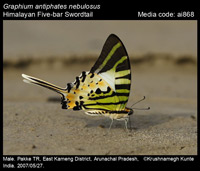
2. Indian Jezebel (Delias eucharis): A vibrantly patterned flying jewel, whose colour scheme is similar to haldi kumukum, which has considerable significance in Indian culture. This bold pattern has evolved to show off its toxic nature, which protects it against many predators. It is widely distributed in India, frequenting gardens and other lightly wooded areas.
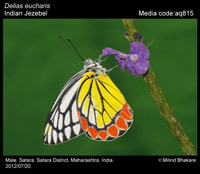
3. Indian Nawab (Charaxes bharata): The Indian Nawab is widely distributed in moist forests across the country, where people may easily see it. Its robust body, powerful, fast movements, intricately embellished underside of the wings, and a shield-like head of its caterpillar, reflect certain aspects of Indian royalty for which this group of butterflies is named.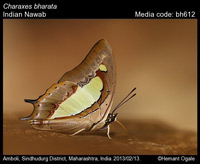
4. Krishna Peacock (Papilio krishna): One of the most beautiful, large and exceedingly charismatic swallowtail butterflies in the world. The species represents the Himalaya, its stronghold, acting as a flagship species for biodiversity and conservation in the face of climate change in this most critical biodiversity hotspot of India. The play of light on the special nanostructures on its hindwings produce the brilliant blue colour patch. Its name invokes among Indian people a deep cultural connection.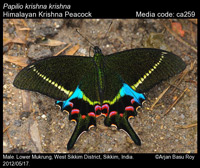
5. Orange Oakleaf (Kallima inachus): The Orange Oakleaf is a large, colorful butterfly with a beautiful deep blue sheen and a striking orange band on the upper side of its wings, making it immediately recognizable. However, its underside superbly resembles a dried leaf, helping it masquerade like one to escape predators in the moist forests of central, northern and northeastern India where it occurs.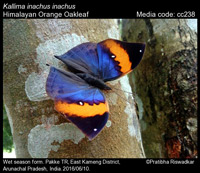
6. Northern Junglequeen (Stichophthalma camadeva): An extraordinarily large size, beautiful cerulean-blue upper side and striking red eyespots on its underside make this one of the most attractive butterflies in India. Being powerful, it holds its own against small predators. Although normally conspicuous, it can blend among the forest when it rests with wings folded on its back. Some of the traditional weaving patterns of Mishmi communities in Arunachal Pradesh, where it occurs widely, are inspired by the wing patterns of this butterfly.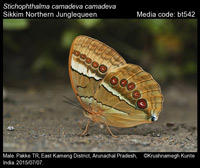
7. Yellow Gorgon (Meandrusa payeni): The strangely angled wings, large size and bright yellow colouration of its underside make this an instantly recognizable butterfly. It has a powerful flight and a habit of rapidly flying up and down hill slopes and forest streams of the eastern Himalaya and NE India, which is an awe-inspiring sight to behold in nature.
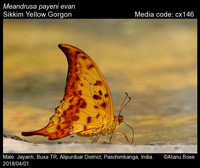
We would like to express our gratitude to Mr. Nawang G. Bhutia, Mr. Atanu Bora, Mr. Monsoon Jyoti Gogoi, Dr. Krushnamegh Kunte, Mr. Ishwar Maanay, Mr. Arjan Basu Roy, Dr. Kalesh Sadasivan, Mr. Vivek Sarkar, and Mr. Sharan Venkatesh for contributing the photographs.